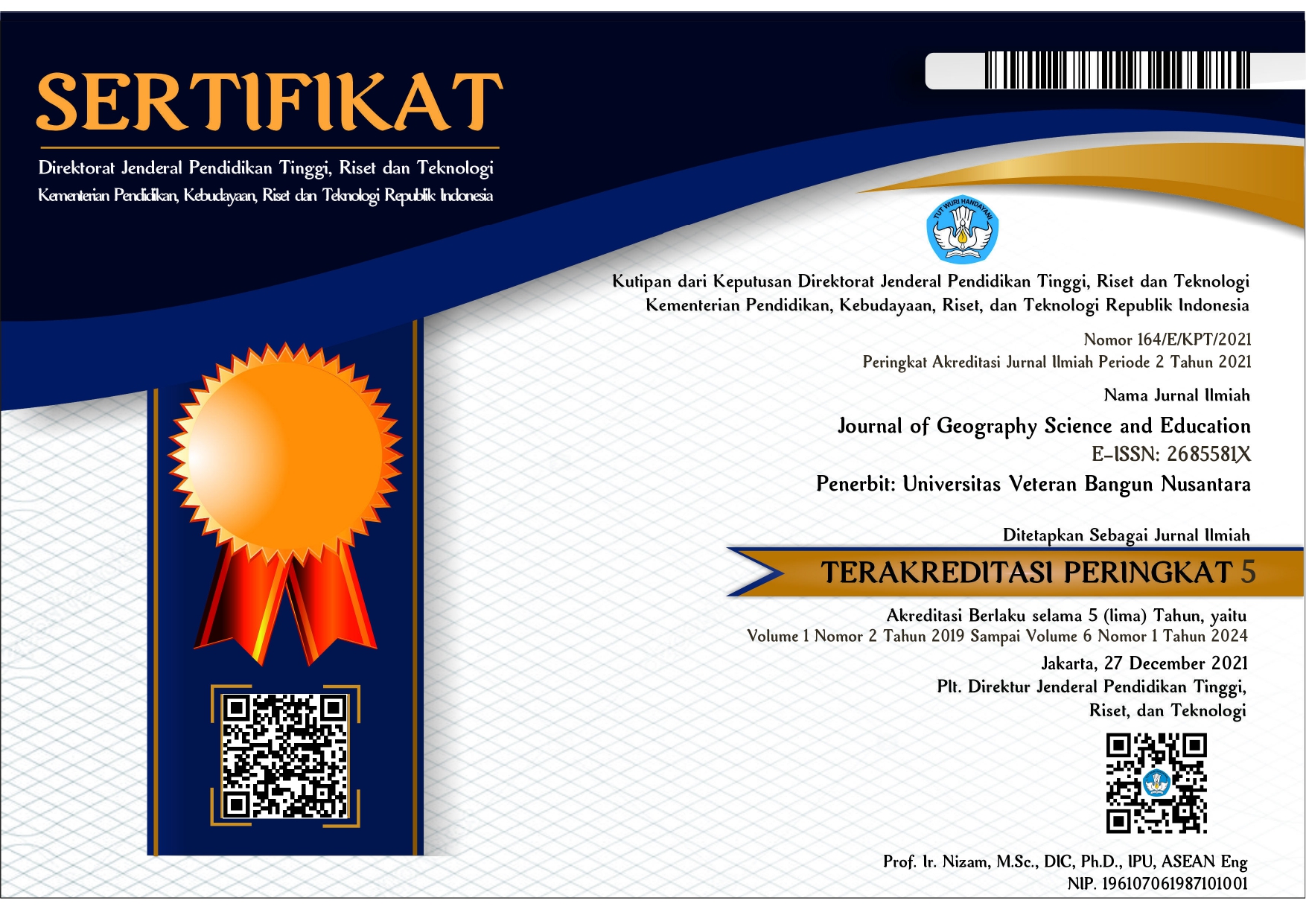THE SPATIAL ANALYSIS OF KITE HOME INDUSTRY IN GROGOL VILLAGE, GROGOL SUB DISTRICT SUKOHARJO DISTRICT IN 2018
DOI:
https://doi.org/10.32585/jgse.v1i1.273Abstrak
The research objective was to find out: (1) Distribution of kite industry homes, (2) social and economic conditions of kite craftsmen, (3) Factors of production and production that support the existence of kite home industries in Grogol Village, Grogol District Sukoharjo. The study used a spatial description data analysis method obtained from the Central Bureau of Statistics of Sukoharjo Regency and used questionnaire questionnaire and data calculation using the frequency table formula. The data contains data from interviews. Data collection techniques used are through interviews, observation and documentation. Data analysis techniques use spatial correlation. The results of the study are: (1) Distribution of kite industry home in 2018 which has a total of 20 industries (2) The social and economic conditions of kite craftsmen in Grogol Village in 2018 are quite good (3) Factors supporting the production of kites includes raw materials, business capital, labor, marketing, and industrial locations.Unduhan
Referensi
Damsar dan Indrayani. 2009. Pengantar Sosiologi Ekonomi. Jakarta: PRENADAMEDIA GROUP
Ig. Dodiet Aditya Setyawan, SKM. 2013. Disribusi Frekuensi. Poltekkes Kemenkes Surakarta. Pertemuan IV. http ://www.slideshare.net
Kamus Besar Bahasa Indonesia halaman 890 tahun 2011
Khoerudin, 2017. Koordinasi Eksternal Dinas Lalu Lintas dan Angkutan Jalan tentang Implementasi Sistem Satu Arah Kota Bogor. Jurnal Governansi.
Kiefer, and Lillesand. 1990. Penginderaan Jauh dan Interpretasi Citra. Jogjakarta: UGM Press.
Lestari,Sri. Tahun 2013. 45 Permainan tradisional anak Indonesia. Yogyakarta:langen sari publishing.
Marfai, Aris. 2015. Pemodelan Geografi. Yogyakarta : Ombak
Modul 3. analisis spasial. Bandung : Kemenristek, 2013.
Moleong, Lexy. J. 2007. Metode Penelitian Kualitatif. Bandung: Rosda Karya
Slamet, Wiyono. 2012. Management Potensi Diri. Jakarta: Grasindo.
Republik Indonesia tanggal 29 juni 1984. Undang – undang Nomor 5 Tahun 84 tentang perindustrian oleh Presiden. Lembaran Negara RI Tahun 1984, dibuat di Jakarta.
Republik Indonesia tanggal 26 Desember 1995. Undang – undang Nomor 9 Tahun 95 tentang Usaha Kecil oleh Presiden. Lembaran Negara RI Tahun 1995, dibuat di Jakarta.
Republik Indonesia 2014. Undang – undang Nomor 3 Tahun 2014 tentang perindustrian oleh Presiden. Lembaran Negara RI Tahun 2014, dibuat di Jakarta
Soekanto, Soerjono dan Budi Sulistyowati. 2015. Sosiologi Suatu Pengantar. Jakarta: RajaGrafindo Persada
Sugiyono, 2008. Metode Penelitian Kuantitatif, Kualitatif dan R&D. Bandung : Penerbit Alfabet
Sutanto, 1994. Penginderaan Jauh dan Interpretasi Citra Jilid 1, cetakan III. Jogjakarta: UGM Press.
Sutanto, 1994. Penginderaan Jauh dan Interpretasi Citra Jilid 2, cetakan III. Jogjakarta :UGM Press
Tika, Moh. Pabundu.2005. Metode Penelitian Geografi. Jakarta: Gramedia Pustaka Utama
Unduhan
Diterbitkan
Cara Mengutip
Terbitan
Bagian
Lisensi
License and Copyright Agreement
In submitting the manuscript to the journal, the authors certify that:
- They are authorized by their co-authors to enter into these arrangements.
- The work described has not been formally published before, except in the form of an abstract or as part of a published lecture, review, thesis, or overlay journal. Please also carefully read JGSE's Posting Your Article Policy at http://pubs2.ascee.org/index.php/ijele/about/editorialPolicies#custom-5
- That it is not under consideration for publication elsewhere,
- That its publication has been approved by all the author(s) and by the responsible authorities – tacitly or explicitly – of the institutes where the work has been carried out.
- They secure the right to reproduce any material that has already been published or copyrighted elsewhere.
- They agree to the following license and copyright agreement.
Copyright
Authors who publish with Journal of Geography Science and Education agree to the following terms:
- Authors retain copyright and grant the journal right of first publication with the work simultaneously licensed under a Creative Commons Attribution License (CC BY-SA 4.0) that allows others to share the work with an acknowledgment of the work's authorship and initial publication in this journal.
- Authors are able to enter into separate, additional contractual arrangements for the non-exclusive distribution of the journal's published version of the work (e.g., post it to an institutional repository or publish it in a book), with an acknowledgment of its initial publication in this journal.
- Authors are permitted and encouraged to post their work online (e.g., in institutional repositories or on their website) prior to and during the submission process, as it can lead to productive exchanges, as well as earlier and greater citation of published work.
Licensing for Data Publication
Journal of Geography Science and Education use a variety of waivers and licenses, that are specifically designed for and appropriate for the treatment of data:
- Open Data Commons Attribution License, http://www.opendatacommons.org/licenses/by/1.0/ (default)
- Creative Commons CC-Zero Waiver, http://creativecommons.org/publicdomain/zero/1.0/
- Open Data Commons Public Domain Dedication and Licence, http://www.opendatacommons.org/licenses/pddl/1-0/
Other data publishing licenses may be allowed as exceptions (subject to approval by the editor on a case-by-case basis) and should be justified with a written statement from the author, which will be published with the article.
Open Data and Software Publishing and Sharing
The journal strives to maximize the replicability of the research published in it. Authors are thus required to share all data, code or protocols underlying the research reported in their articles. Exceptions are permitted but have to be justified in a written public statement accompanying the article.
The associated persistent identifiers (e.g. DOI, or others) of the dataset(s) must be included in the data or software resources section of the article. Reference(s) to datasets and software should also be included in the reference list of the article with DOIs (where available). Where no domain-specific data repository exists, authors should deposit their datasets in a general repository such as ZENODO, Dryad, Dataverse, or others.
Small data may also be published as data files or packages supplementary to a research article, however, the authors should prefer in all cases a deposition in data repositories.










